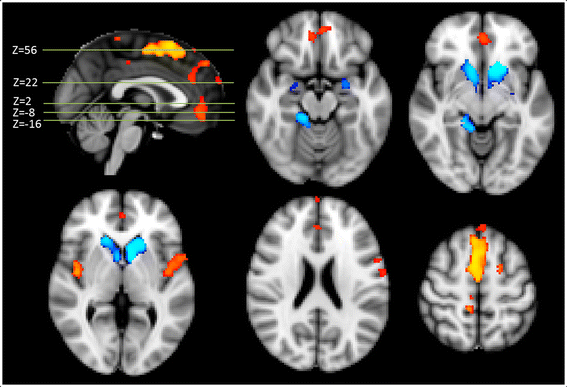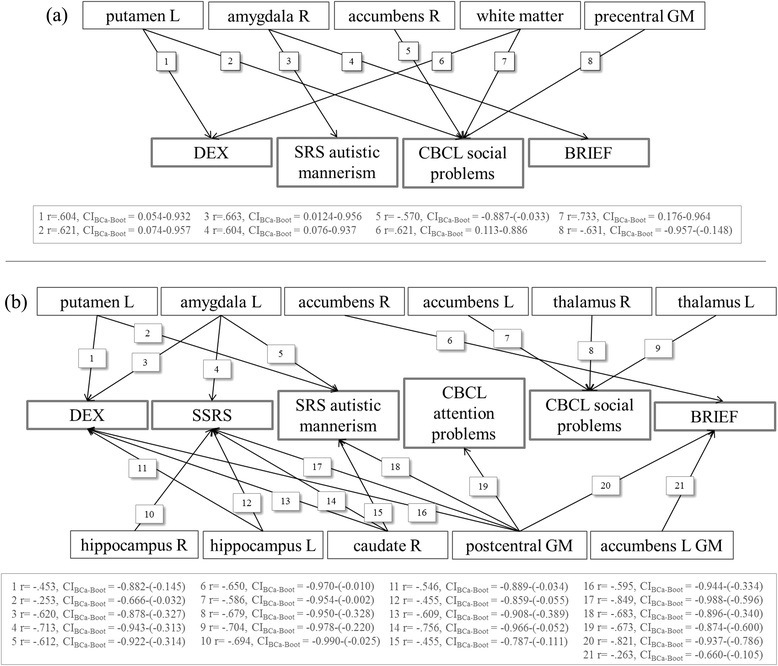Cerebral volumetric abnormalities in Neurofibromatosis type 1: associations with parent ratings of social and attention problems, executive dysfunction, and autistic mannerisms
- PMID: 26473019
- PMCID: PMC4607002
- DOI: 10.1186/s11689-015-9128-3
Cerebral volumetric abnormalities in Neurofibromatosis type 1: associations with parent ratings of social and attention problems, executive dysfunction, and autistic mannerisms
Abstract
Background: Neurofibromatosis type 1 (NF1) is a single-gene neurodevelopmental disorder, in which social and cognitive problems are highly prevalent. Several commonly observed central nervous system (CNS) abnormalities in NF1 might underlie these social and cognitive problems. Cerebral volumetric abnormalities are among the most consistently observed CNS abnormalities in NF1. This study investigated whether differences were present between NF1 patients and healthy controls (HC) in volumetric measures of cortical and subcortical brain regions and whether differential associations existed for NF1 patients and HC between the volumetric measures and parent ratings of social skills, attention problems, social problems, autistic mannerisms, and executive dysfunction.
Methods: Fifteen NF1 patients (mean age 12.9 years, SD 2.6) and 18 healthy controls (HC, mean age 13.8 years, SD 3.6) underwent 3 T MRI scanning. Segmentation of cortical gray and white matter, as well as volumetry of subcortical nuclei, was carried out. Voxel-based morphometry was performed to assess cortical gray matter density. Correlations were calculated, for NF1-patients and HC separately, between MRI parameters and scores on selected dimensions of the following behavior rating scales: the Social Skills Rating System, the Child Behavior Checklist, the Social Responsiveness Scale, the Behavior Rating Inventory of Executive Functioning, and the Dysexecutive Questionnaire.
Results: After correction for age, sex, and intracranial volume, larger volumes of all subcortical regions were found in NF1 patients compared to controls. Patients further showed decreased gray matter density in midline regions of the frontal and parietal lobes and larger total white matter volume. Significantly more social and attention problems, more autistic mannerisms, and poorer executive functioning were reported for NF1 patients compared to HC. In NF1 patients, larger left putamen volume and larger total white matter volume were associated with more social problems and poorer executive functioning, larger right amygdala volume with poorer executive functioning and autistic mannerisms, and smaller precentral gyrus gray matter density was associated with more social problems. In controls, only significant negative correlations were observed: larger volumes (and greater gray matter density) were associated with better outcomes.
Conclusions: Widespread volumetric differences between patients and controls were found in cortical and subcortical brain regions. In NF1 patients but not HC, larger volumes were associated with poorer behavior ratings.
Keywords: Executive and social functioning; Gray matter; Magnetic resonance imaging; Neurofibromatosis type 1; Subcortical volume; Voxel-based morphometry.
Figures


Similar articles
-
Functional Connectivity Changes and Executive and Social Problems in Neurofibromatosis Type I.Brain Connect. 2015 Jun;5(5):312-20. doi: 10.1089/brain.2014.0334. Epub 2015 Mar 31. Brain Connect. 2015. PMID: 25705926 Free PMC article.
-
Abnormal Morphology of Select Cortical and Subcortical Regions in Neurofibromatosis Type 1.Radiology. 2018 Nov;289(2):499-508. doi: 10.1148/radiol.2018172863. Epub 2018 Sep 4. Radiology. 2018. PMID: 30179114 Free PMC article.
-
A preliminary study of synthetic magnetic resonance imaging on the changes of subcortical gray matter nuclei in obstructive sleep apnea patients.Quant Imaging Med Surg. 2025 May 1;15(5):3911-3922. doi: 10.21037/qims-24-1830. Epub 2025 Apr 14. Quant Imaging Med Surg. 2025. PMID: 40384657 Free PMC article.
-
Brain volumes in genetic syndromes associated with mTOR dysregulation: a systematic review and meta-analysis.Mol Psychiatry. 2025 Apr;30(4):1676-1688. doi: 10.1038/s41380-024-02863-4. Epub 2024 Dec 5. Mol Psychiatry. 2025. PMID: 39633008
-
Cortical and Subcortical Gray Matter Volume in Youths With Conduct Problems: A Meta-analysis.JAMA Psychiatry. 2016 Jan;73(1):64-72. doi: 10.1001/jamapsychiatry.2015.2423. JAMA Psychiatry. 2016. PMID: 26650724 Review.
Cited by
-
PTPN11 Gain-of-Function Mutations Affect the Developing Human Brain, Memory, and Attention.Cereb Cortex. 2019 Jul 5;29(7):2915-2923. doi: 10.1093/cercor/bhy158. Cereb Cortex. 2019. PMID: 30059958 Free PMC article.
-
Novel effects of Ras-MAPK pathogenic variants on the developing human brain and their link to gene expression and inhibition abilities.Transl Psychiatry. 2023 Jul 6;13(1):245. doi: 10.1038/s41398-023-02504-4. Transl Psychiatry. 2023. PMID: 37407569 Free PMC article.
-
Discriminating between neurofibromatosis-1 and typically developing children by means of multimodal MRI and multivariate analyses.Hum Brain Mapp. 2019 Aug 15;40(12):3508-3521. doi: 10.1002/hbm.24612. Epub 2019 May 11. Hum Brain Mapp. 2019. PMID: 31077476 Free PMC article.
-
A new era for myelin research in Neurofibromatosis type 1.Glia. 2023 Dec;71(12):2701-2719. doi: 10.1002/glia.24432. Epub 2023 Jun 29. Glia. 2023. PMID: 37382486 Free PMC article. Review.
-
Social Communication in Ras Pathway Disorders: A Comprehensive Review From Genetics to Behavior in Neurofibromatosis Type 1 and Noonan Syndrome.Biol Psychiatry. 2025 Mar 1;97(5):461-498. doi: 10.1016/j.biopsych.2024.09.019. Epub 2024 Oct 2. Biol Psychiatry. 2025. PMID: 39366539
References
-
- National Institutes of Health. Consensus Development Conference Statement. Neurofibromatosis. Arch Neurol. 1988, 45:575–8. - PubMed
-
- Steen RG, Taylor JS, Langston JW, Glass JO, Brewer VR, Reddick WE, Mages R, Pivnick EK. Prospective evaluation of the brain in asymptomatic children with neurofibromatosis type 1: relationship of macrocephaly to T1 relaxation changes and structural brain abnormalities. AJNR Am J Neuroradiol. 2001;22:810–7. - PMC - PubMed
Grants and funding
LinkOut - more resources
Full Text Sources
Other Literature Sources
Research Materials
Miscellaneous

